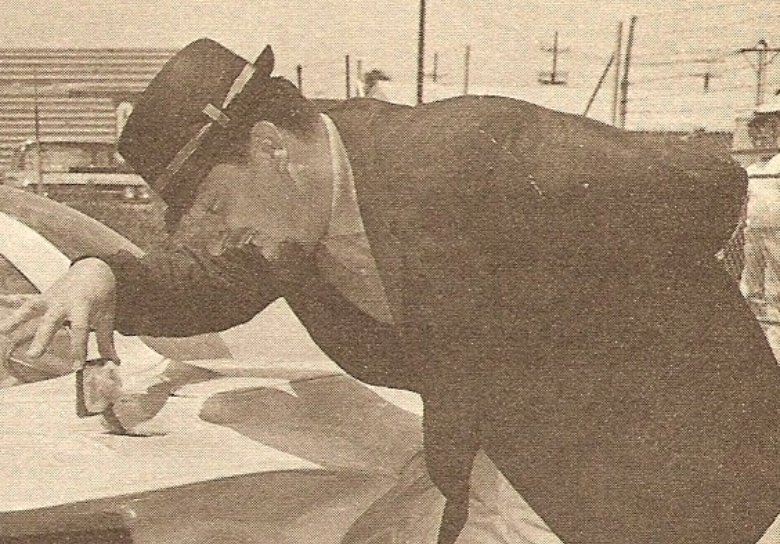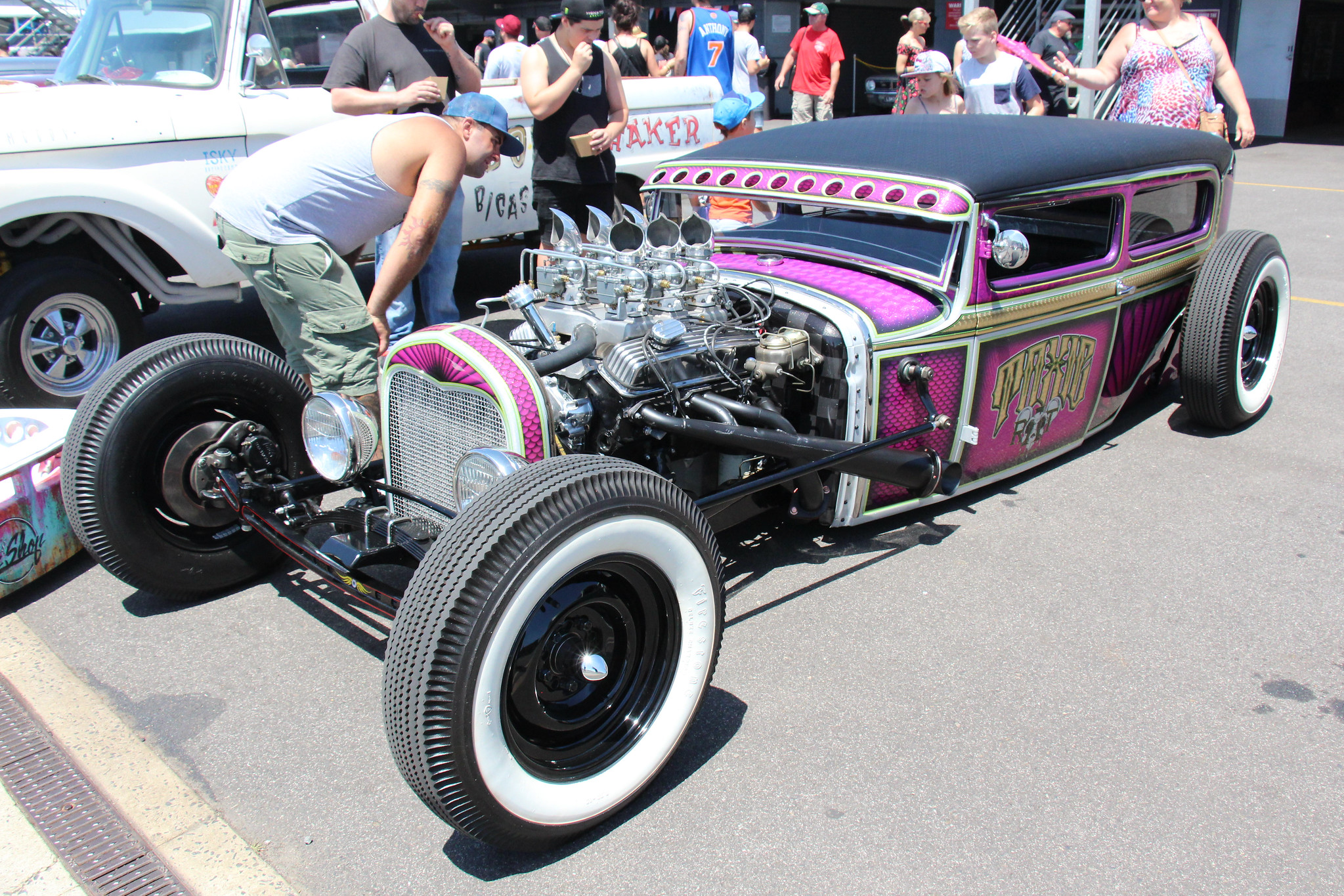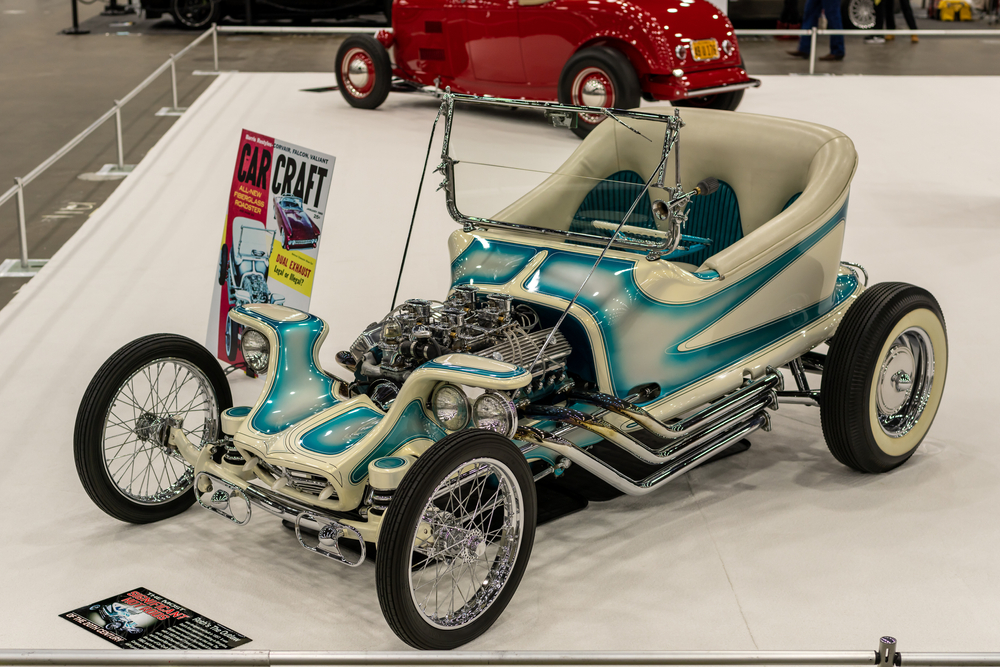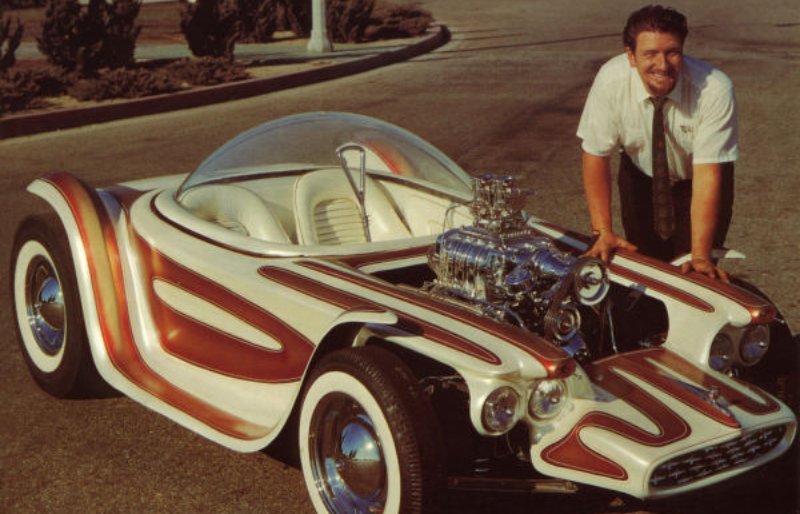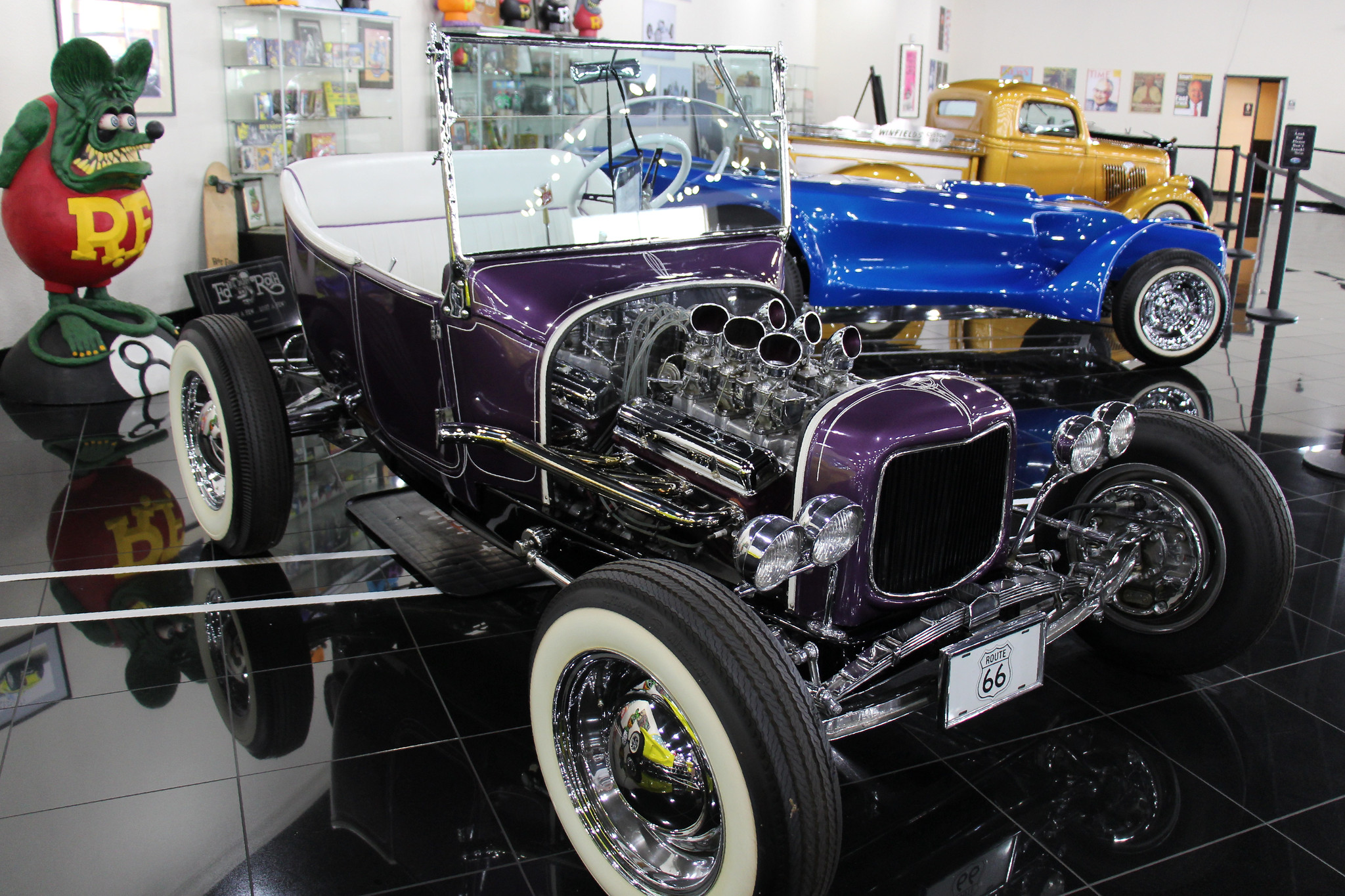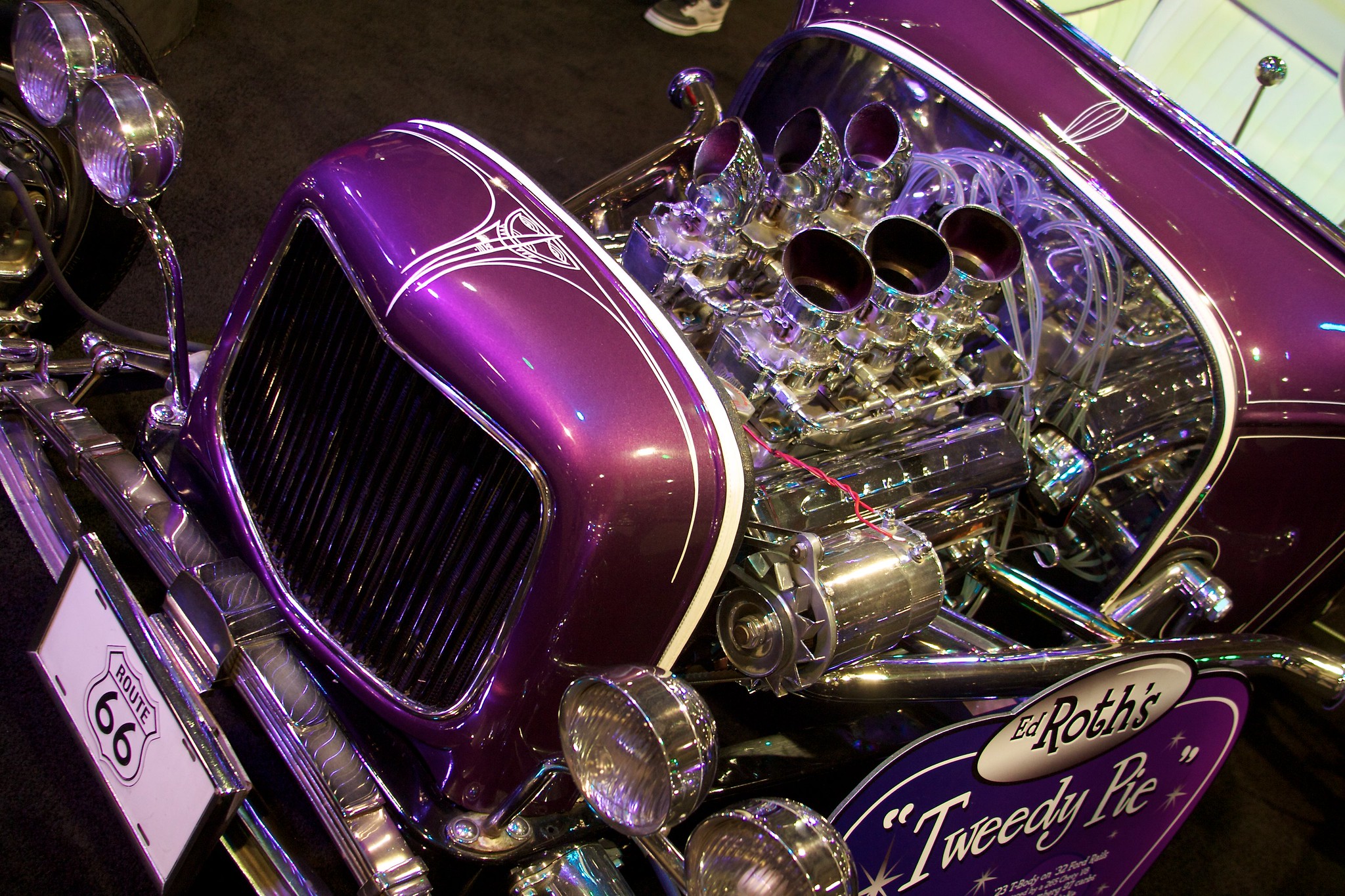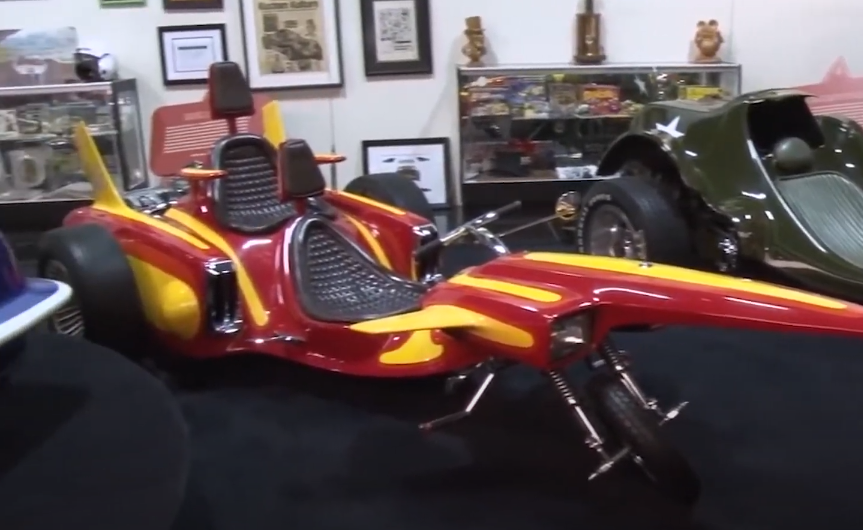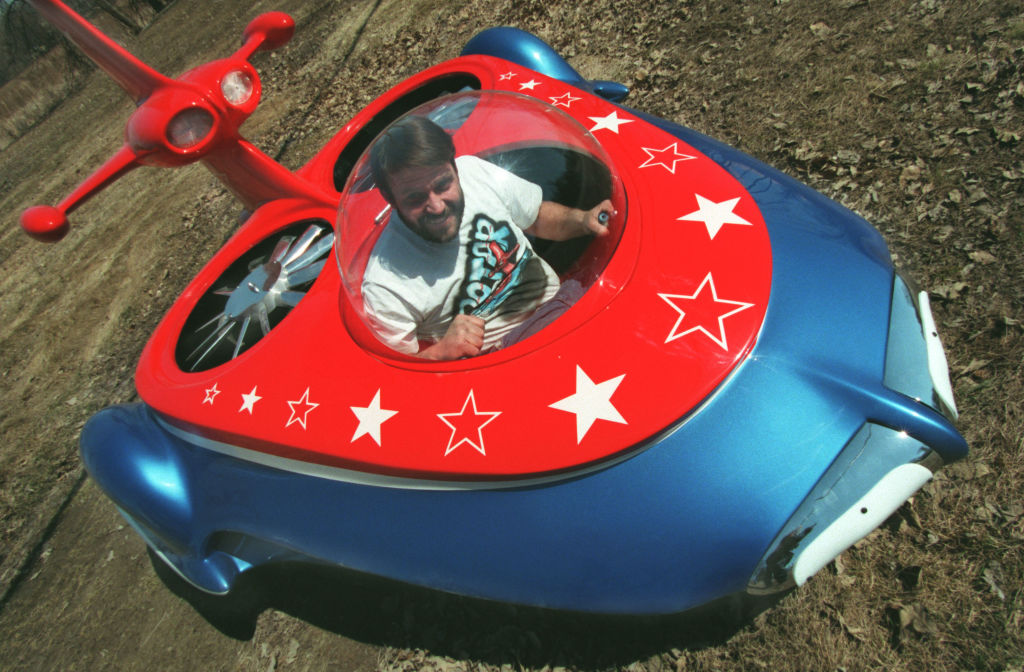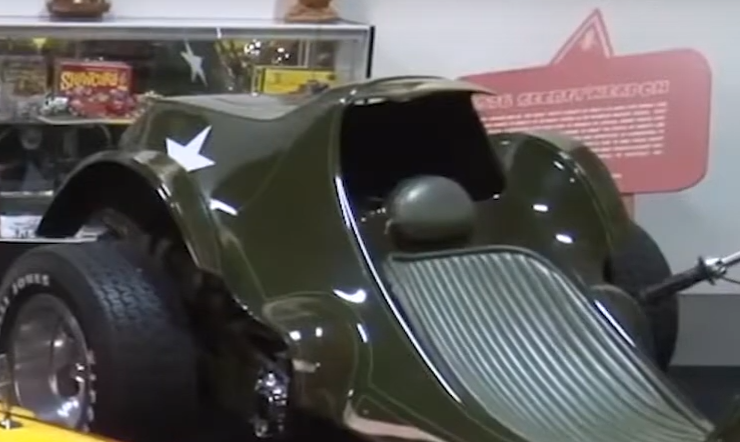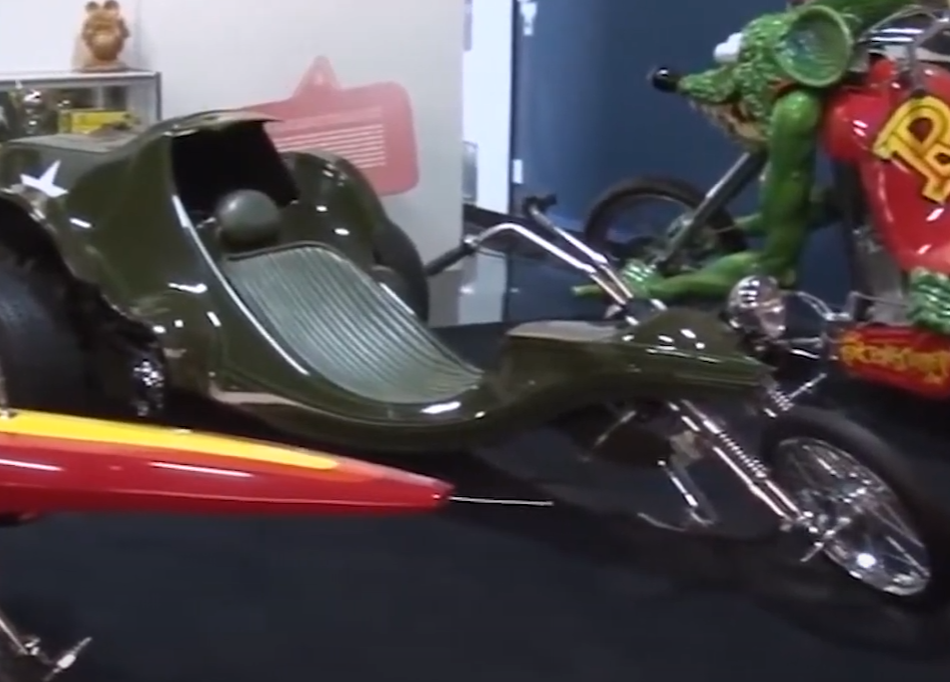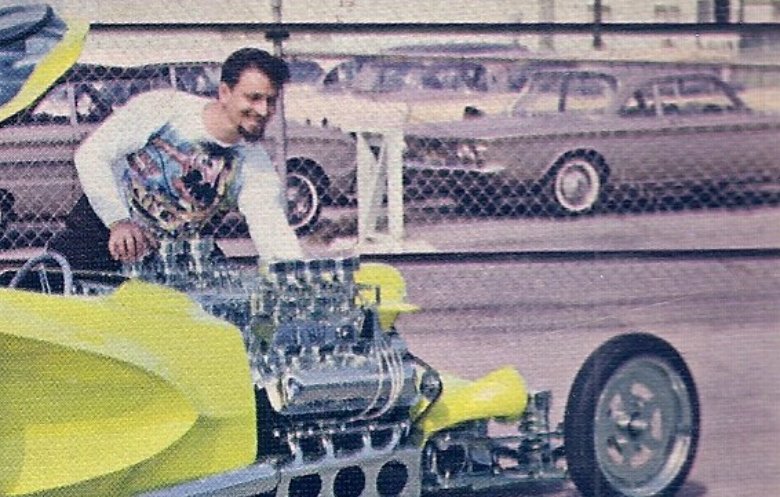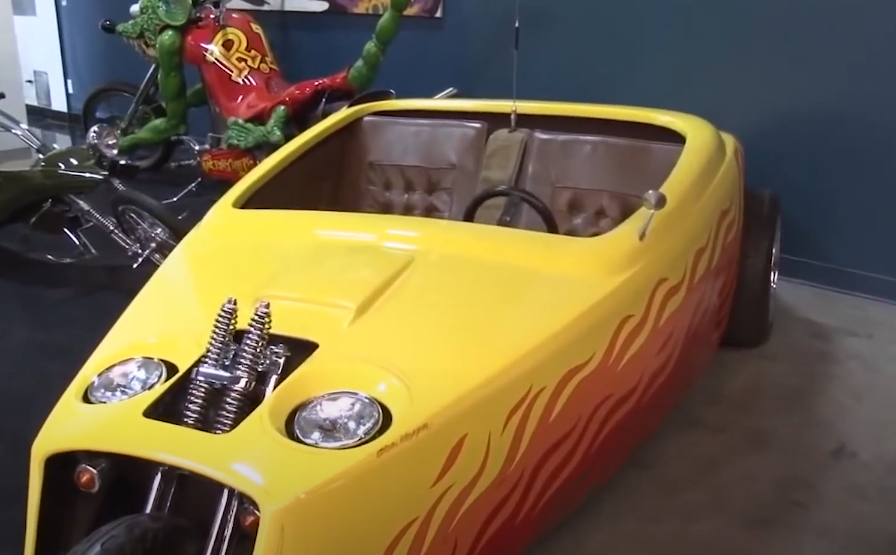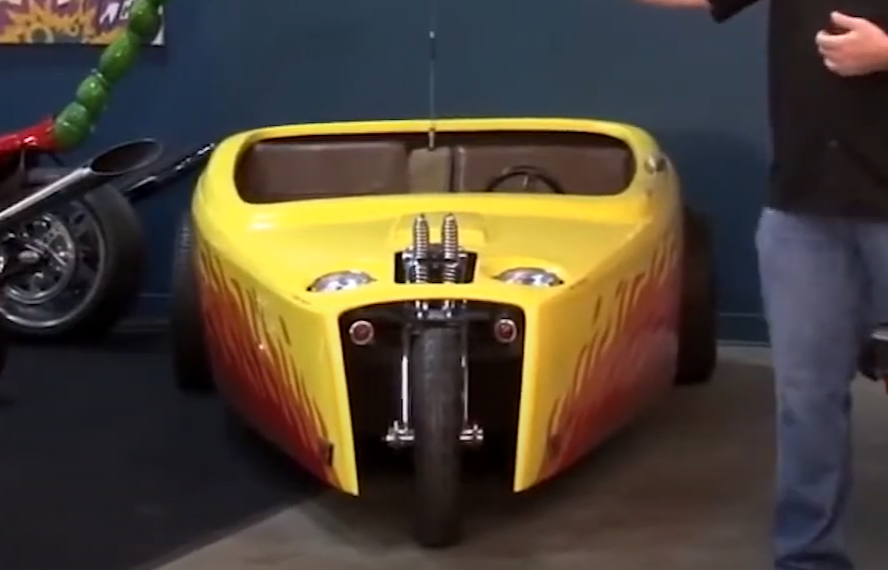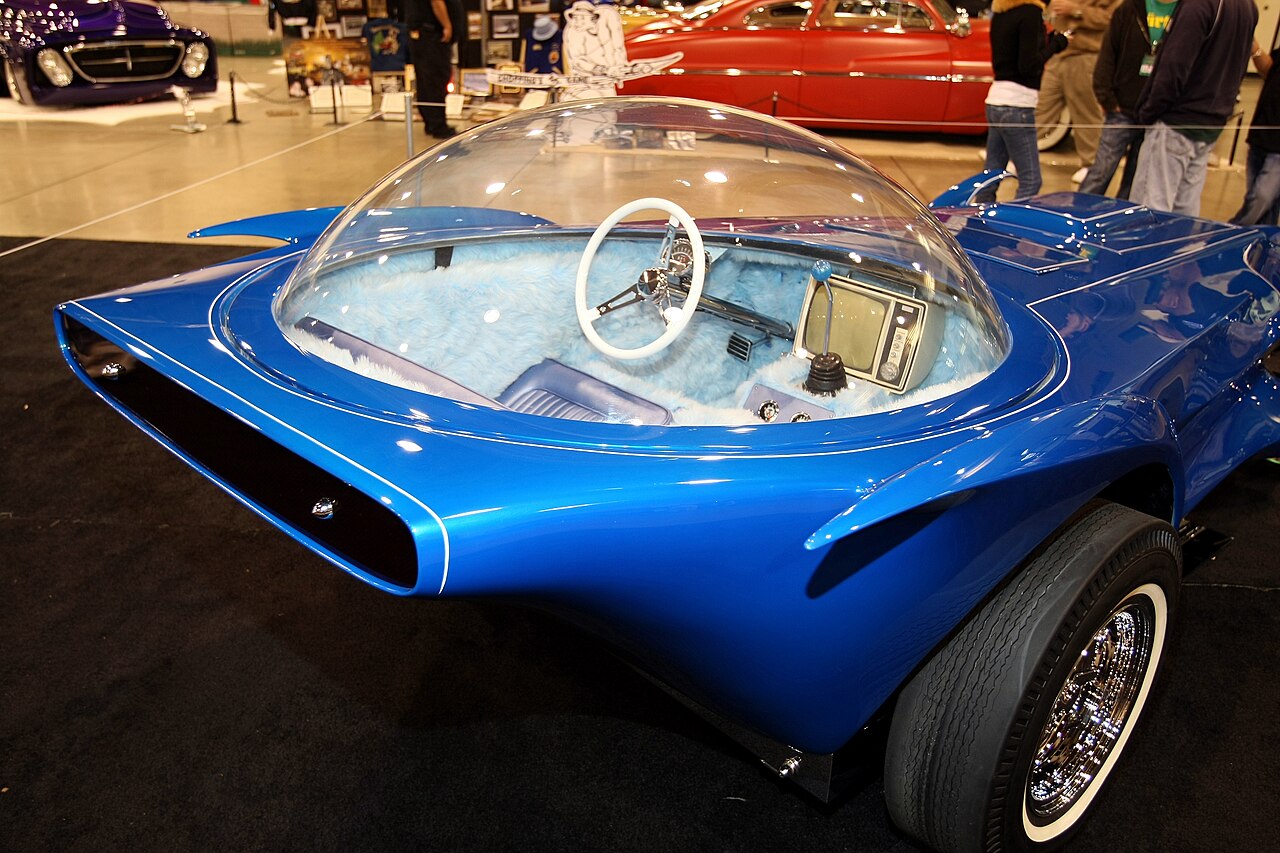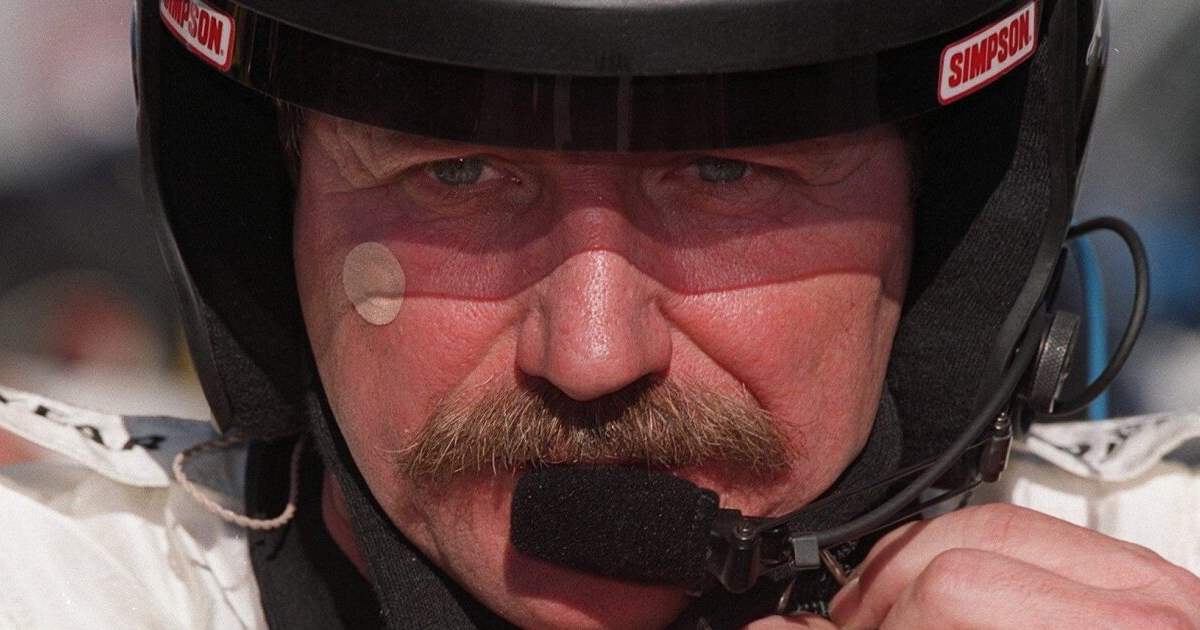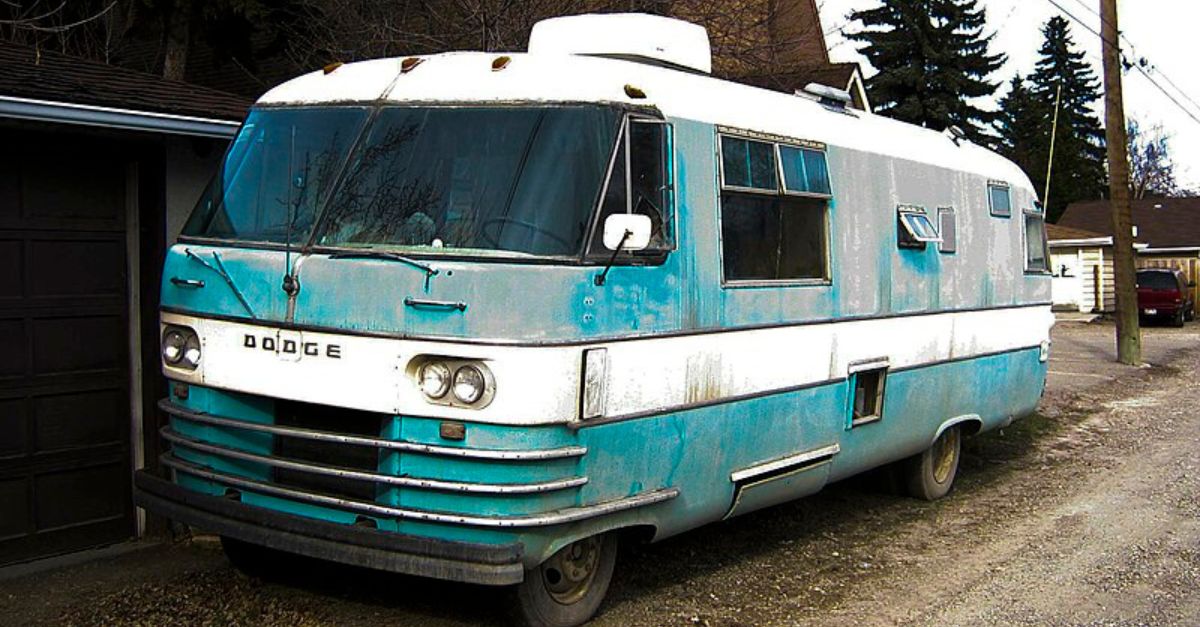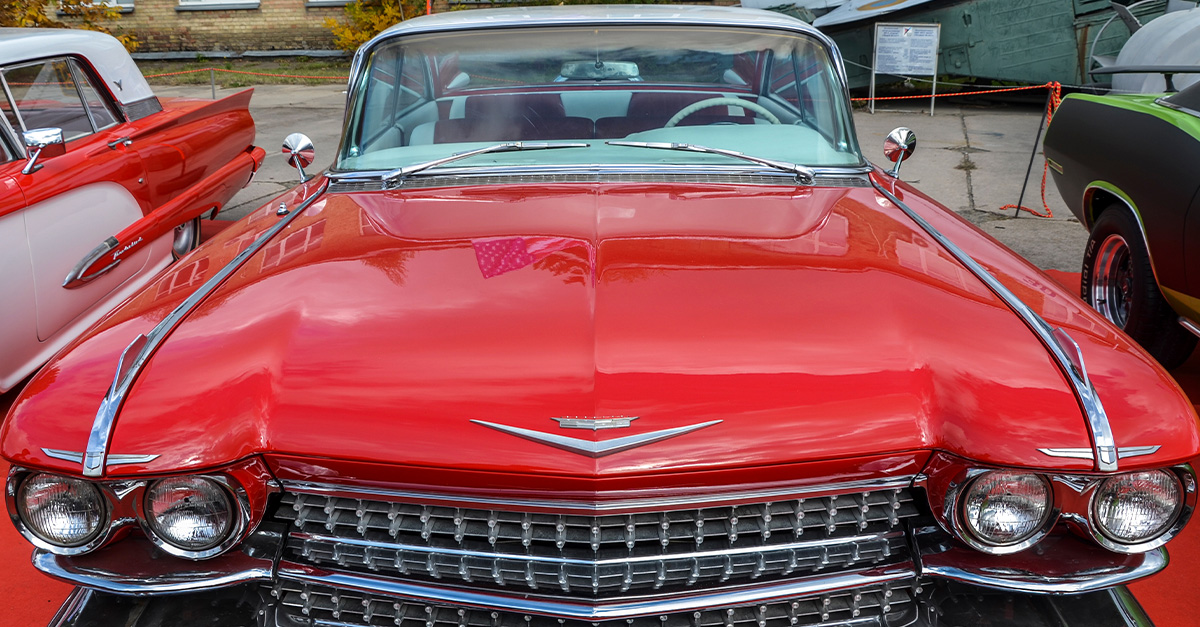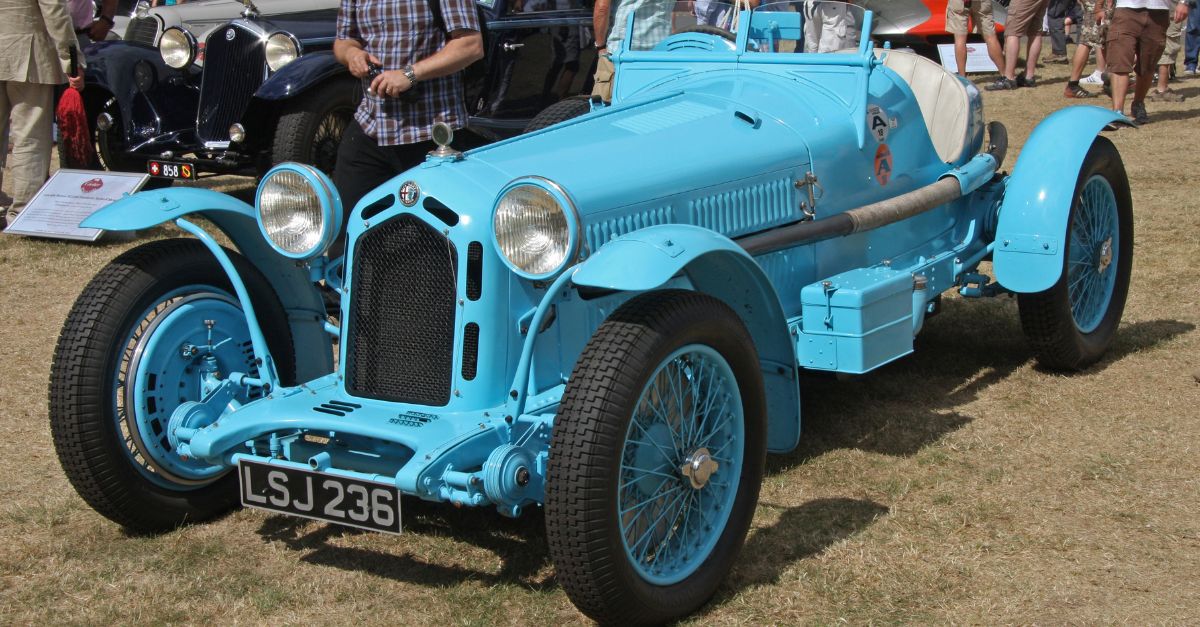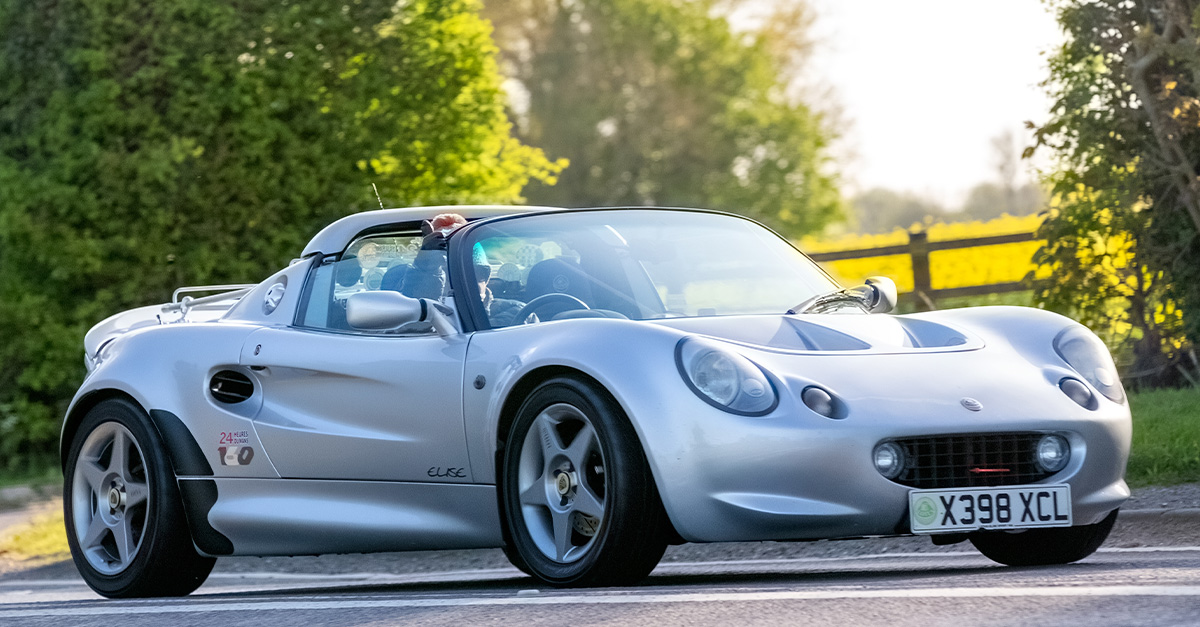A Legend Of The Hot Rod Movement
Ed "Big Daddy" Roth wore so many hats—his talent was overflowing. He was an artist and cartoonist, with his most famous character being the iconic Rat Fink. But on top of his artwork, he was also a pinstriper and custom car designer, making a name for himself throughout the '50s, '60s, and beyond.
Stay tuned for a look at some of his most memorable creations.
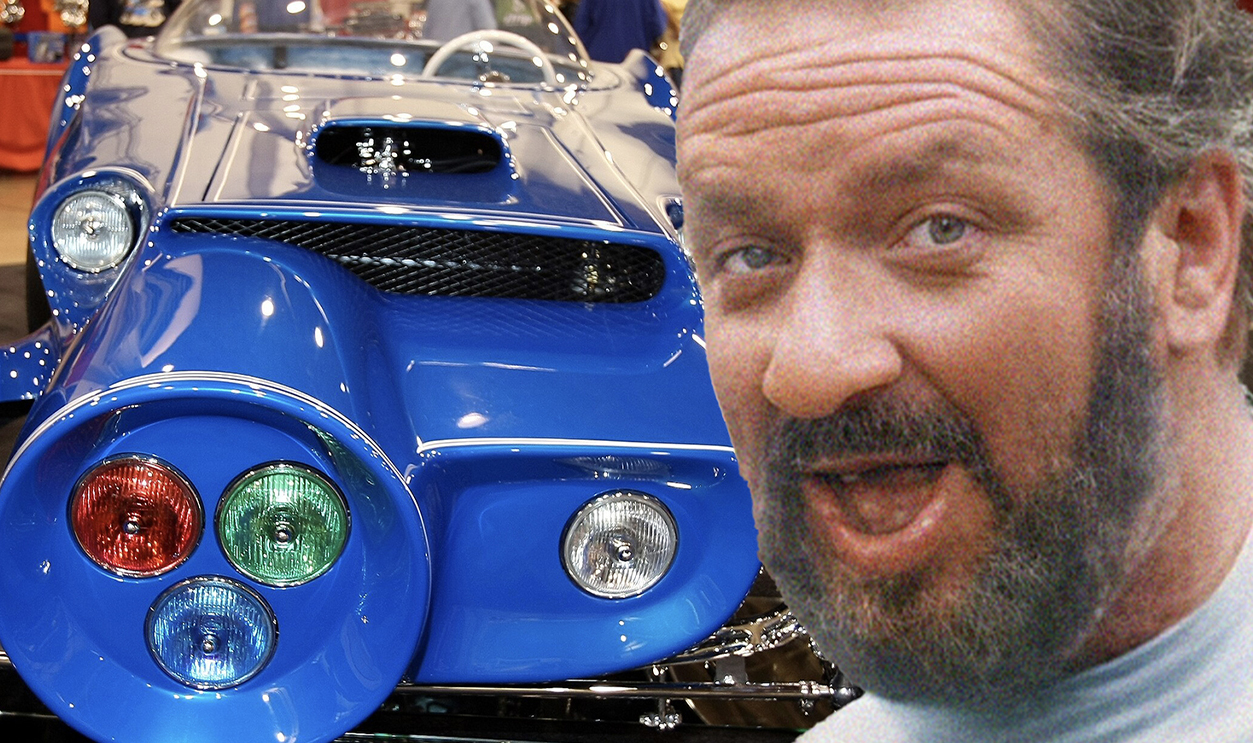
He Had Art In His Blood
Born in 1932, the legend that is Ed "Big Daddy" Roth had a childhood that certainly hinted that he had a future in the arts. Growing up in Bell, California, Ed had a knack for drawing early on. His imagination teemed with hot rods, fun characters, and flying planes. But this was only the beginning.
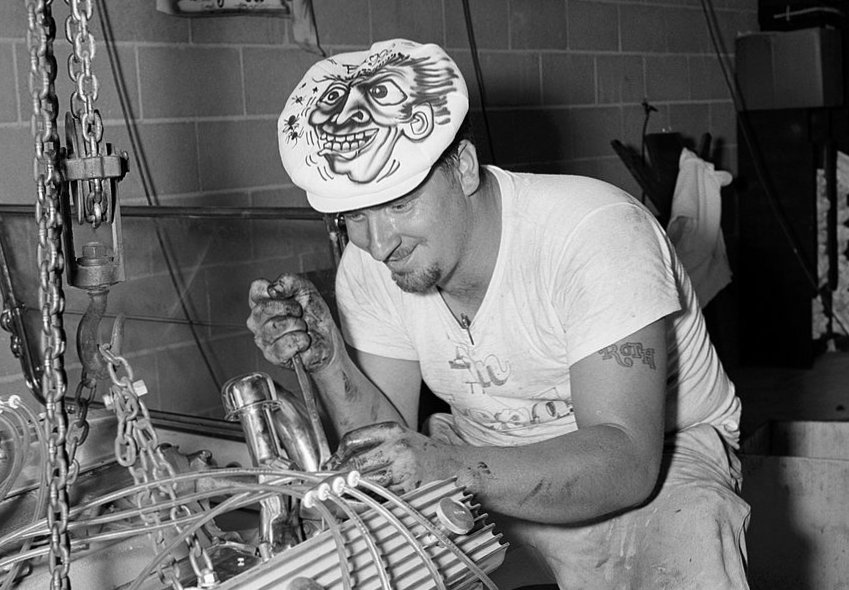 The Enthusiast Network, Getty Images
The Enthusiast Network, Getty Images
He Became A Pinstripe Artist
1958 was the year Ed began working with cars in earnest alongside Bud "The Baron" Crozier and Tom Kelly. Together, they ran a custom paint shop called "Crazy Painters," offering their pinstriping services. But that wasn't all Ed got up to.
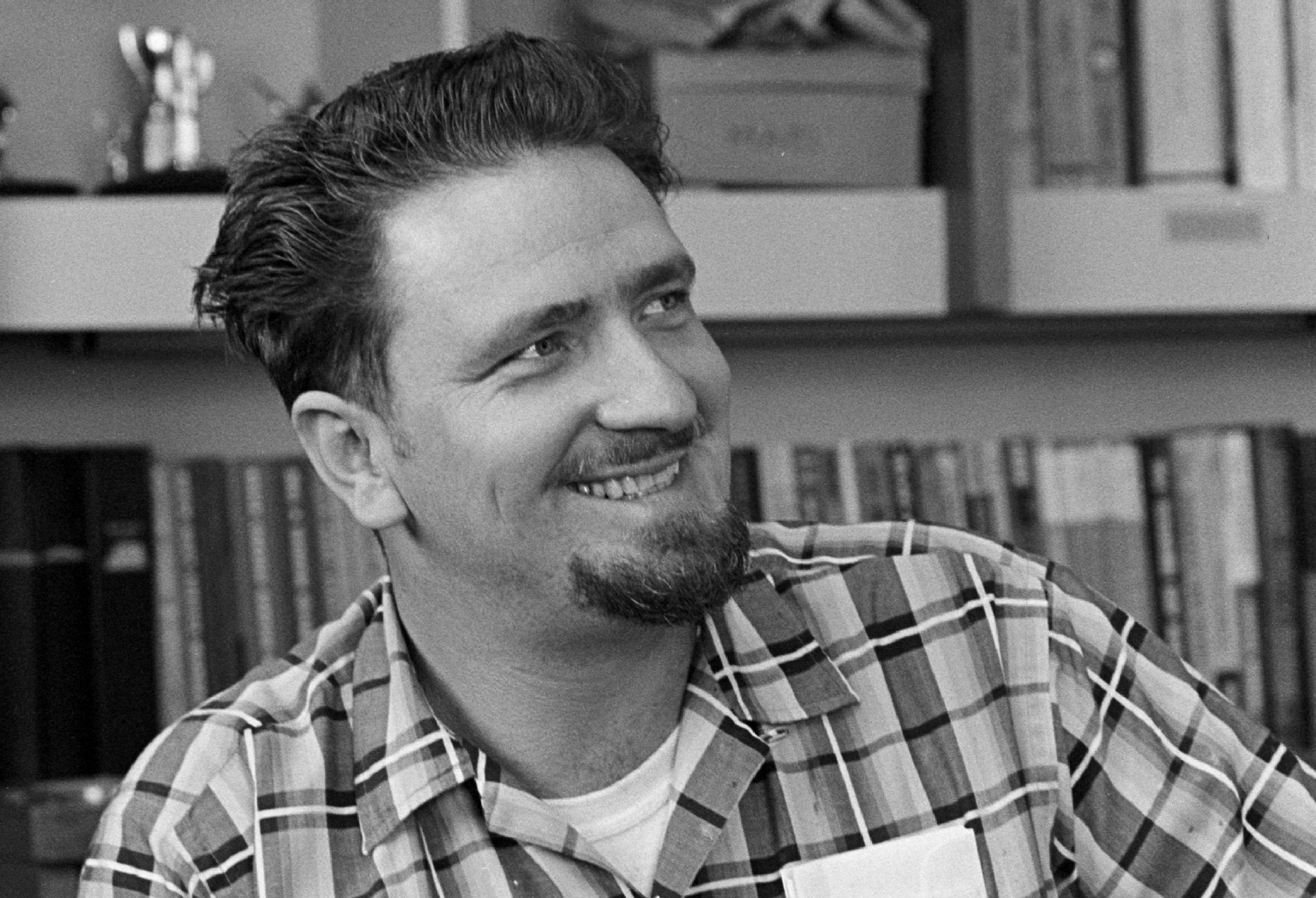 The Enthusiast Network, Getty Images
The Enthusiast Network, Getty Images
He Got Creative With It
In addition to customizing clients' cars with his own artistic touch, Ed also experimented with making cars himself. He worked with fiberglass, as well as parts that he managed to scrounge from the junkyard. His custom cars were certainly a sight to behold.
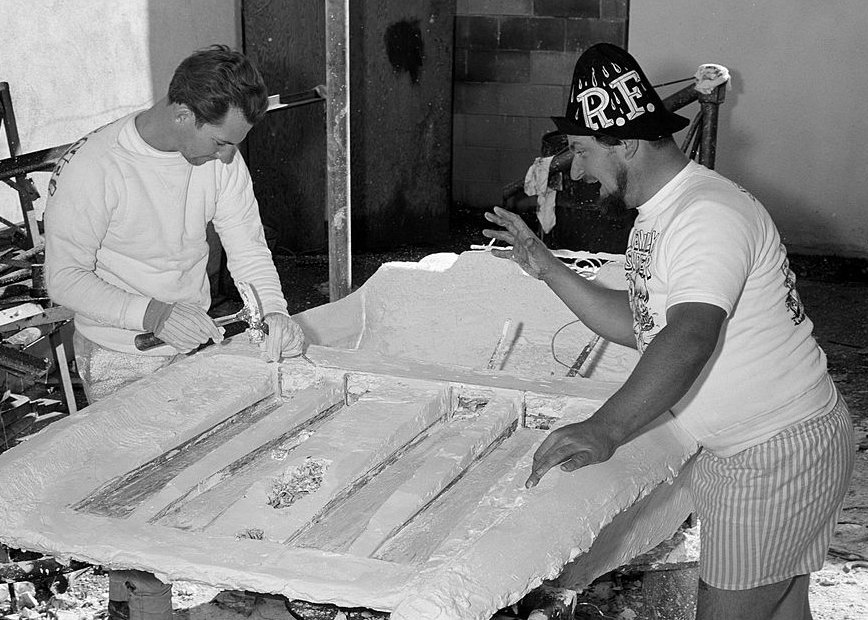 The Enthusiast Network, Getty Images
The Enthusiast Network, Getty Images
Little Jewel (1958)
Ed Roth's very first custom car had an adorable name—Little Jewel. It was a 1930 Model A Tudor, boasting a free paint job by Wally Jordan, who chose a stunning red color (though the car was eventually repainted). But that wasn't all.
Little Jewel (1958)
Roth made some notable changes to the 1930 Model A Tudor. For instance, he customized Little Jewel with a 1932 Ford grille, and made his very own turn lights and nerf bars. He also swapped out the engine, replacing it with a 1950 Oldsmobile engine, among other changes.
But when it came to Ed's long list of custom cars, Little Jewel was only the tip of the iceberg. Let's take a look at some of his other wacky creations.
The Outlaw (1959)
The Outlaw was a very important hot rod as it marked a first in Ed's books. It was the very first time he'd put his plaster and fiberglass technique into practice. As well, the car almost had a completely different name.
The Outlaw (1959)
Fascinatingly, Ed used a family heirloom in constructing the car. For the shifter, he used a real Revolutionary War sword—and its history could be traced back through the family of his mother-in-law. Therefore, he'd initially planned to name the car Excaliber. Unfortunately, there was just one problem.
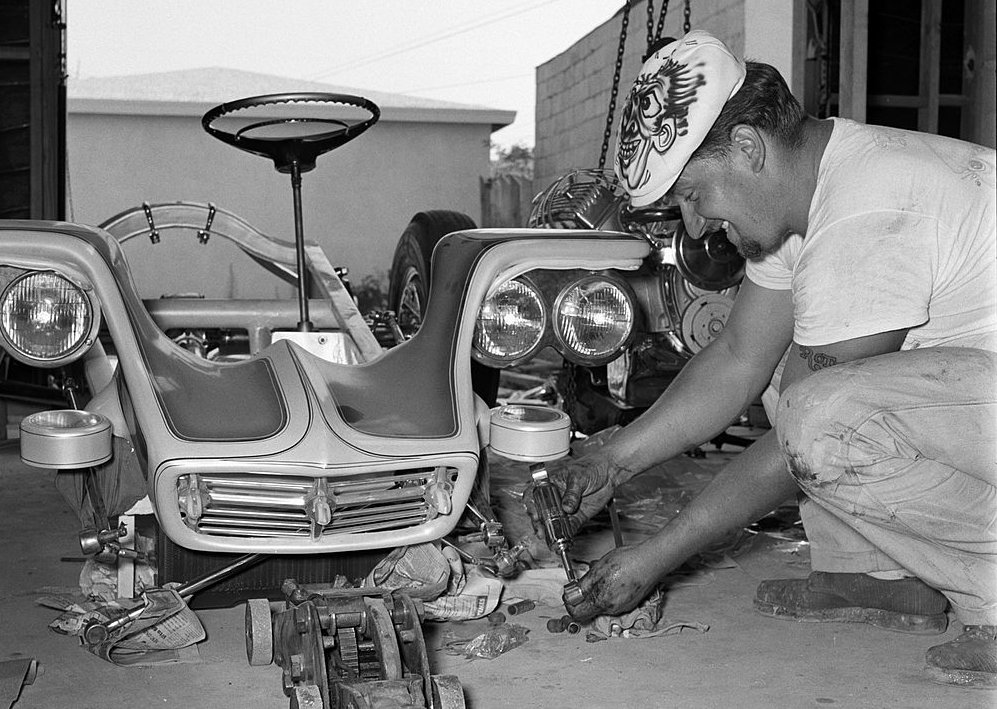 The Enthusiast Network, Getty Images
The Enthusiast Network, Getty Images
The Outlaw (1959)
As it turned out, Excaliber's pronunciation really stumped some people. Therefore, Ed eventually landed on the name The Outlaw. Additionally, Ed actually had to sell the aforementioned Little Jewel to afford the chrome used in Outlaw's construction.
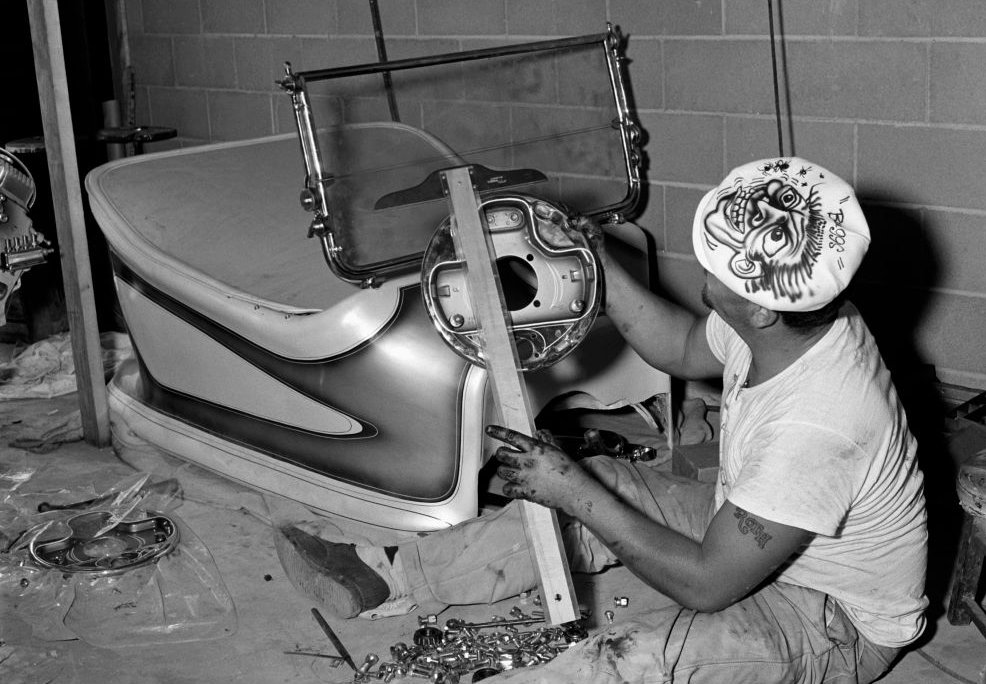 The Enthusiast Network, Getty Images
The Enthusiast Network, Getty Images
Beatnik Bandit (1961)
If you know your Hot Wheels, then you're bound to recognize the tell-tale look of the Beatnik Bandit with its fun bubble top. After all, it was one of the original 16 Hot Wheels designs—and for good reason.
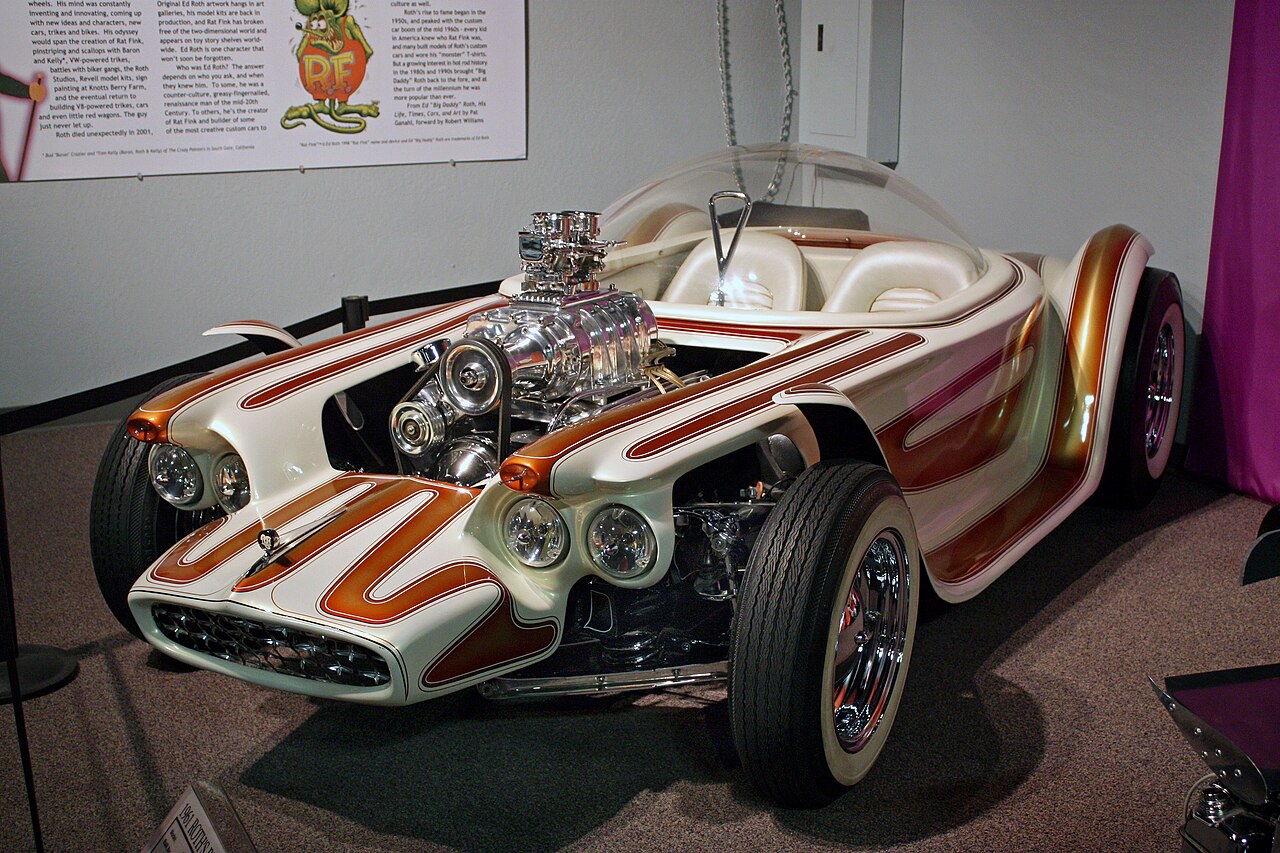 Nick Ares, CC BY-SA 2.0, Wikimedia Commons
Nick Ares, CC BY-SA 2.0, Wikimedia Commons
Beatnik Bandit (1961)
The foundation of the Beatnik Bandit is a 1955 Olds chassis, with a few modifications of course. Ed changed the length to 85 inches. The car also features an Oldsmobile engine and twin Ford carbs.
Surfite (1964)
The Surfite looks exactly as it sounds—a car literally tailor-made for surfers. Equipped with a 1269cc Austin Mini Cooper chrome-plated engine, the foundation of this sunny yellow spectacle was an Austin Mini Cooper chassis.
As it turns out, the Surfite was also something of a movie star.
 Bill Abbott, CC BY-SA 2.0, Wikimedia Commons
Bill Abbott, CC BY-SA 2.0, Wikimedia Commons
Surfite (1964)
When Ed caught wind of a film production happening in Malibu, he felt like the Surfite would be a proper fit for its visuals. Lo and behold, the Surfite does indeed have a small cameo in 1965's Beach Blanket Bingo.
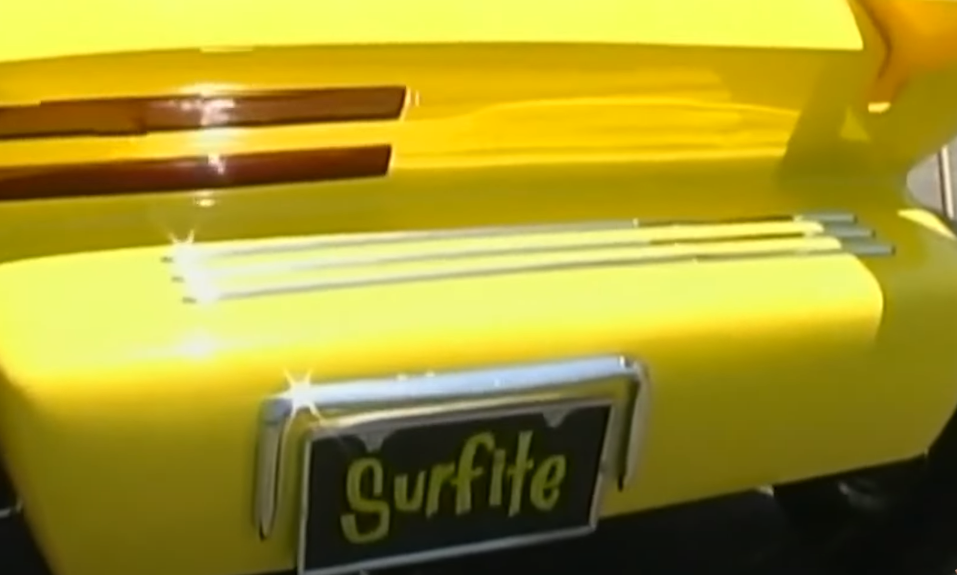 Innovation, Controversy, and Impact of Ed 'Big Daddy' Roth, Net Worth Post
Innovation, Controversy, and Impact of Ed 'Big Daddy' Roth, Net Worth Post
Tweedy Pie (1964)
This purple delight is called Tweedy Pie—and the original owner was actually Bob Johnston. Ed also did some customizations on the 1920 Ford T-bucket for Bob, striping it for him. However, Ed eventually got his hands on the car for himself.
Tweedy Pie (1964)
Before Ed acquired the car, Bob had opted for Tweedy Pie to have a ’57 Corvette engine. Once Ed could play around with it to his heart's content, he wound up making some more additions—like an Offy manifold and six carburetors. He also incorporated chrome into its design and customized the nerf bars.
Druid Princess (1966)
Druid Princess looks like something straight out of a fairy tale. Deco pieces and the use of veiling (a painting technique) made the car look like a winning combo of history and modernity.
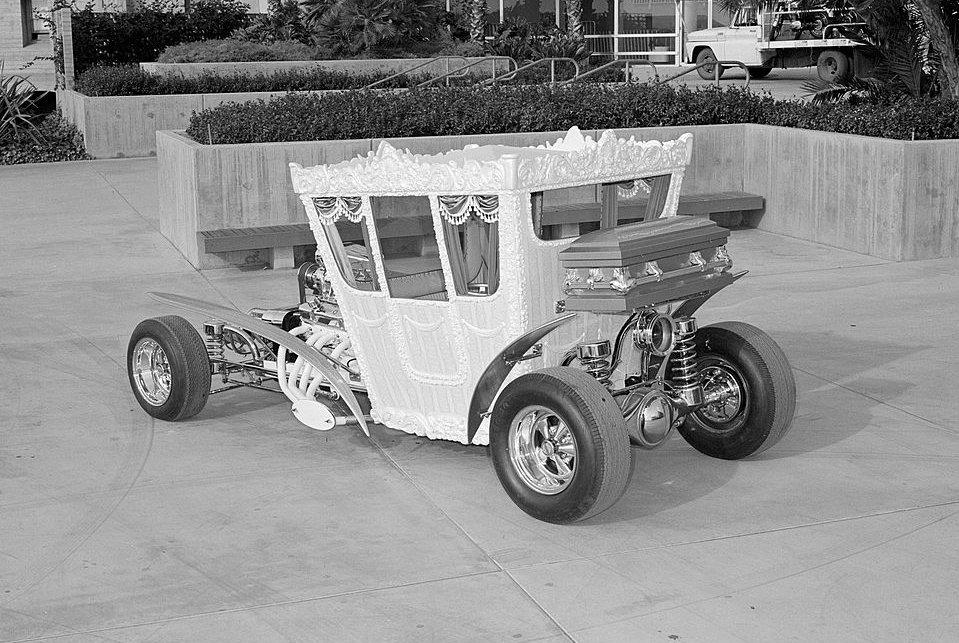 The Enthusiast Network, Getty Images
The Enthusiast Network, Getty Images
Druid Princess (1966)
Some of the Druid's features include a Dodge transmission and engine. As well, the coffin at the rear is home to both the battery and gas tank.
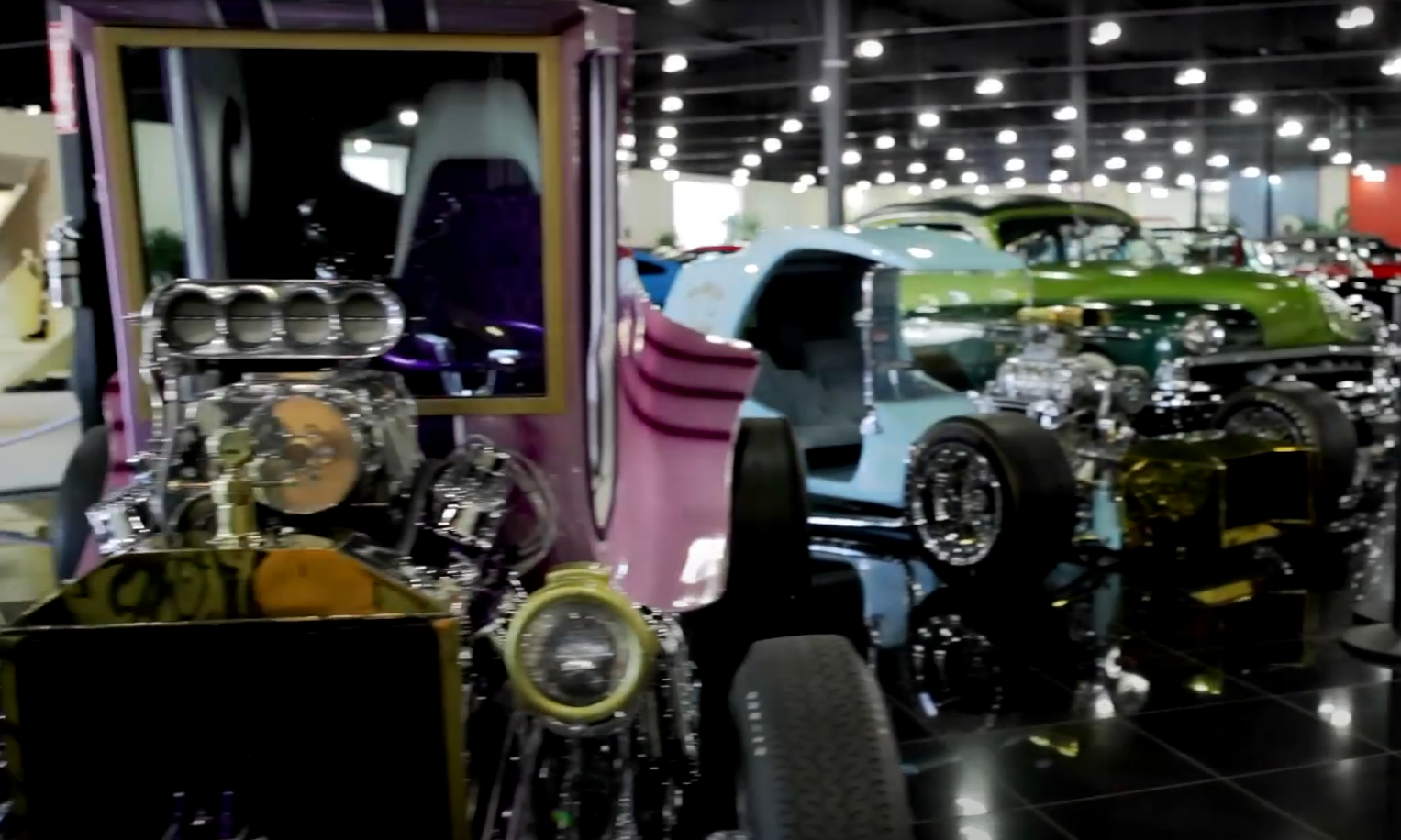 Hover Crafts & Hot Rods - Ed "Big Daddy" Roth's Collection - GQ's Car Collectors - Los Angeles, GQ
Hover Crafts & Hot Rods - Ed "Big Daddy" Roth's Collection - GQ's Car Collectors - Los Angeles, GQ
The Great Speckled Bird (1976)
One of Ed Roth's most impressive trikes—or three-wheelers—is the eye-catching The Great Speckled Bird. With its long lines and red and yellow coloring, this car is bound to stop anyone in their tracks.
The Great Speckled Bird (1976)
The Great Speckled Bird comes with an automatic transmission and a VW Type 4 engine. But perhaps the most novel feature of this trike is the water tank Ed added to it. This, in conjunction with a windshield wiper motor, allowed him to release a spray of water to refresh passengers. Why? Well, because he usually took his cars out into the heat of the desert.
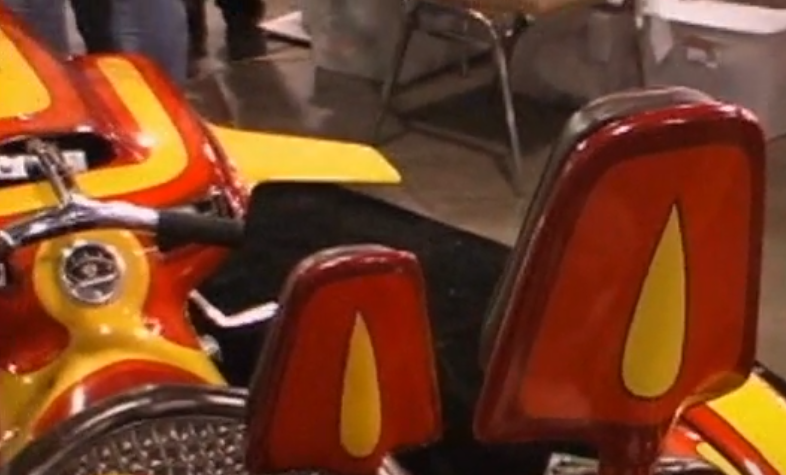 Big Daddy Ed Roths Great Speckle Bird, cruisenwith
Big Daddy Ed Roths Great Speckle Bird, cruisenwith
Rotar (1965)
Now, Rotar might be one of the most astonishing cars on Ed Roth's resume. Rotar, meaning "Roth Air Car," was a flying car—or perhaps, more accurately, it hovered above the ground. Quite impressively, it could navigate on both land and water. However, on one occasion, revving the Rotar went very wrong.
Rotar (1965)
At the Detroit Autorama, the Rotar malfunctioned when the crank broke, and its blades flew out in multiple directions. It was quite a dangerous situation. Reportedly, a woman's purse got wrecked and a blade nailed a young bystander in the head.
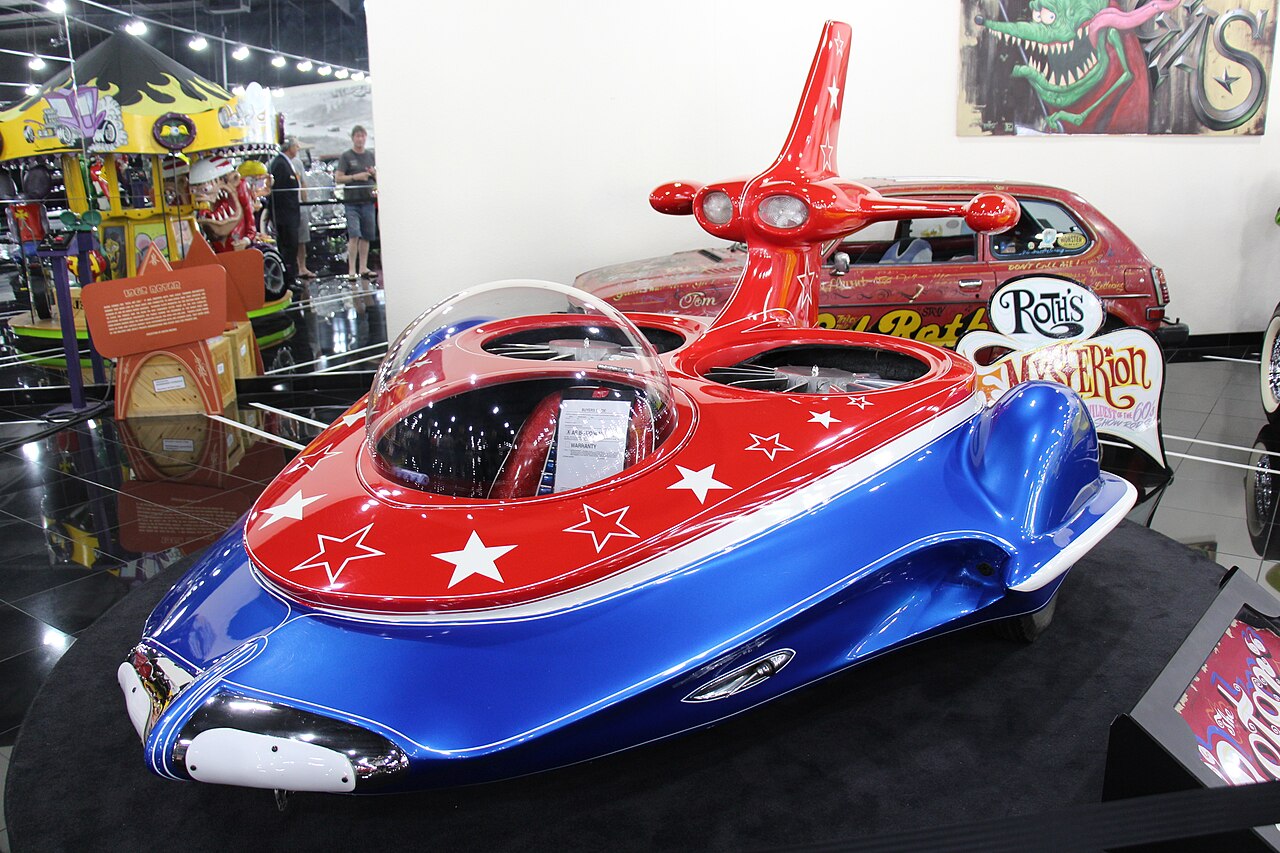 Sicnag, CC BY 2.0, Wikimedia Commons
Sicnag, CC BY 2.0, Wikimedia Commons
Mysterion (1963)
This bright yellow masterpiece is Mysterion. Ed drew inspiration for this car from multi-engine dragsters. He'd witnessed them in action at the dragstrips and decided to create his own unique iteration.
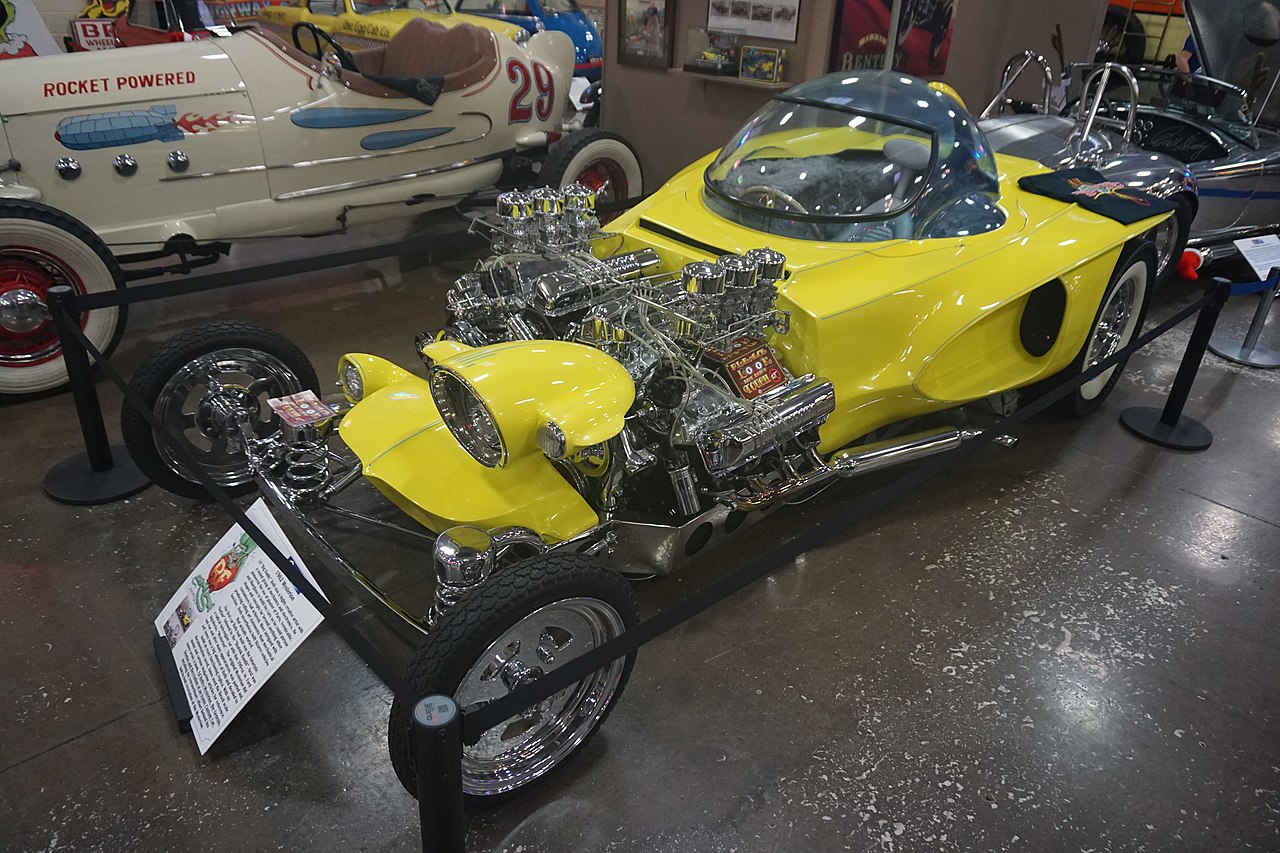 Michael Barera, CC BY-SA 4.0, Wikimedia Commons
Michael Barera, CC BY-SA 4.0, Wikimedia Commons
Mysterion (1963)
The Mysterion certainly boasts an interesting make-up, including two transmissions and a couple of Ford engines. Of course, perhaps the most eye-catching elements of this automobile include the bubble-like cockpit for the driver and the single headlight.
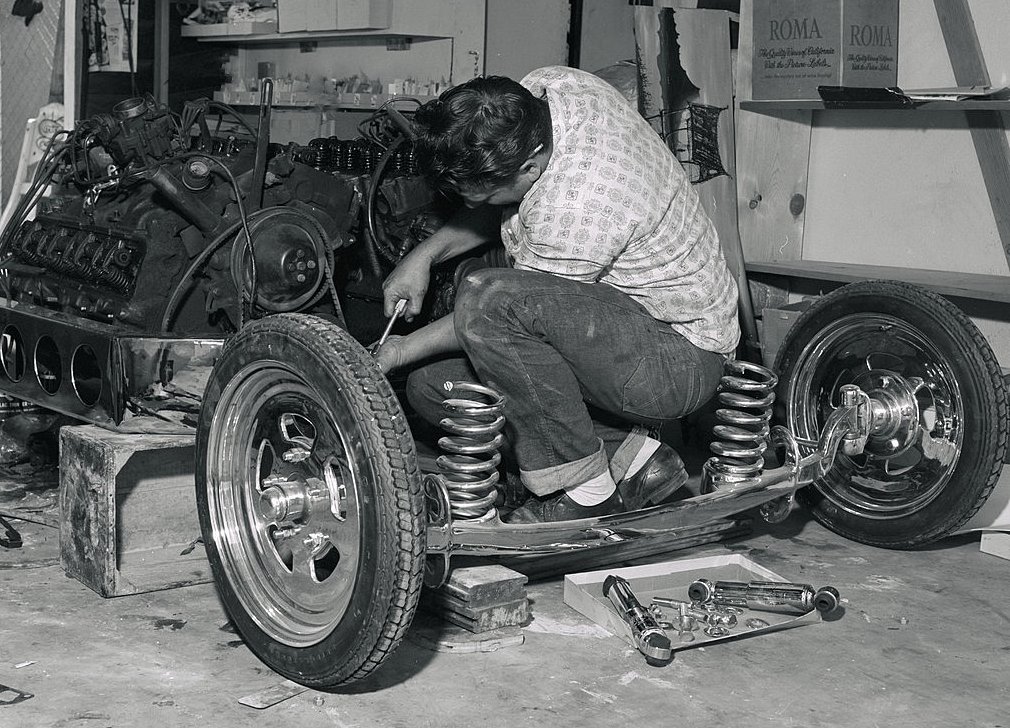 The Enthusiast Network, Getty Images
The Enthusiast Network, Getty Images
Secret Weapon (1976)
In Ed's eyes, his three-wheeler Secret Weapon really exuded the flavor of the US Army—specifically, it was his trike version of an army Jeep. However, it certainly wasn't perfect.
Secret Weapon (1976)
Though Ed had the foresight to build the car with a lower center of gravity for safety's sake, Secret Weapon had a secret flaw. You see, too much of a good thing can actually be an automobile's Achilles' heel—and in the case of Secret Weapon, that was its jaw-dropping comfortability.
Secret Weapon (1976)
Yes, Secret Weapon was just too cozy of a driving experience. In Ed's experience, he couldn't help dozing off while trying to operate it. This probably had to do with its laydown driving position.
Globe Hopper (1987)
Globe Hopper takes inspiration from a '34 Ford Roadster. It's a tiny little marvel, decked out in warm colors (red, yellow, and orange), with a wraparound flame design.
Globe Hopper (1987)
Trikes had certainly been on Ed's brain for over a decade by the time he decided to build the Globe Hopper. Some of its features included a Porsche 914 coupe's automatic transmission, as well as a 1800cc VW engine.
 Paul Conroy, CC BY-SA 3.0, Wikimedia Commons
Paul Conroy, CC BY-SA 3.0, Wikimedia Commons
Globe Hopper (1987)
Eventually opting for two SU carburetors, Ed got behind the wheel of the Globe Hopper and decided to take it on a wildly long road trip. Starting from Los Angeles, he made the Globe Hopper live up to its name, driving it as far as Alaska.
Orbitron (1964)
The Orbitron might have a wild backstory and a pleasing pair of asymmetrical headlights, but in Ed's own words, the car was “a failure at the shows". There's a good chance that it might have done much better if the ’55 Chevy engine could be seen by the public. Instead, he'd opted to keep it concealed.
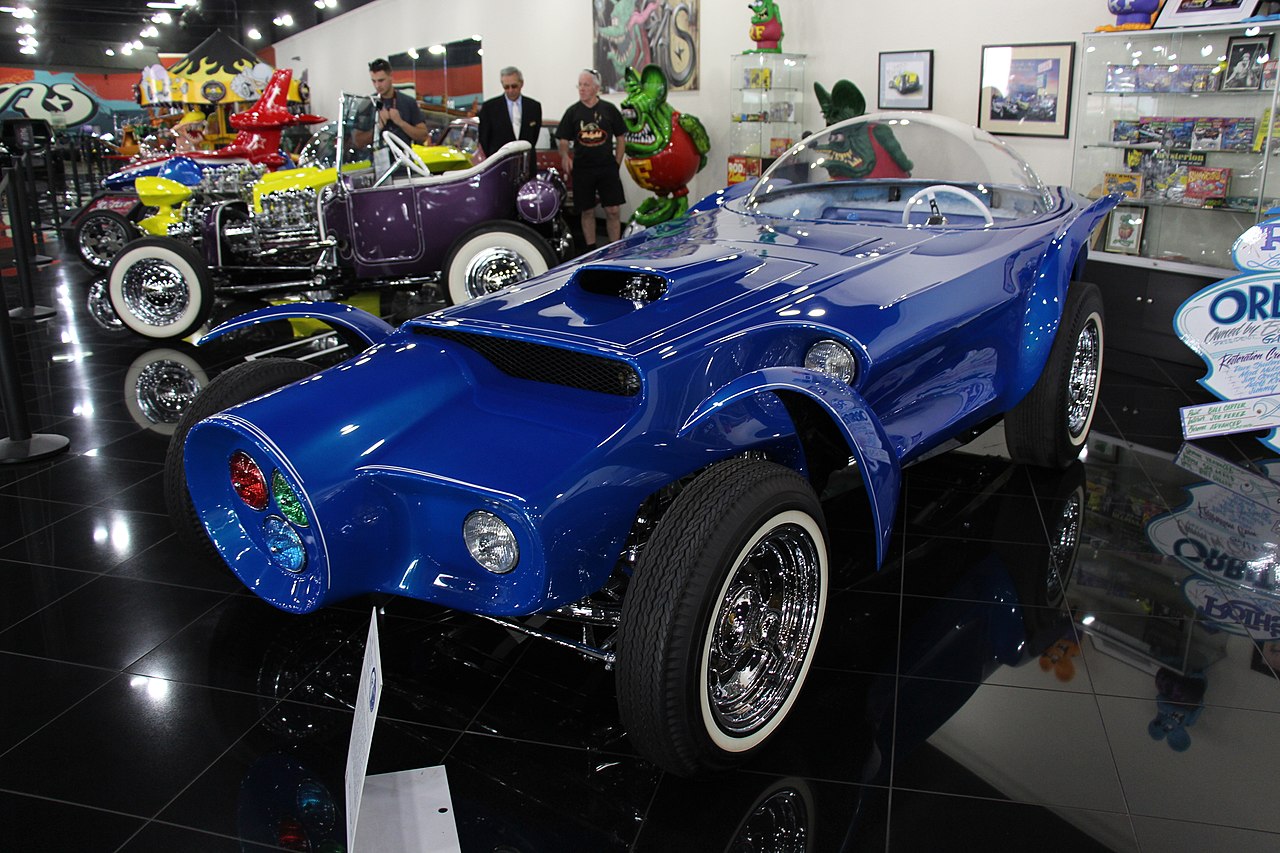 Sicnag, CC BY 2.0, Wikimedia Commons
Sicnag, CC BY 2.0, Wikimedia Commons
Orbitron (1964)
In my opinion, the Orbitron's headlights are its best feature. Ed quite cleverly used primary colors to create one of the headlights. Therefore, when used together in harmony, it produces a white light.
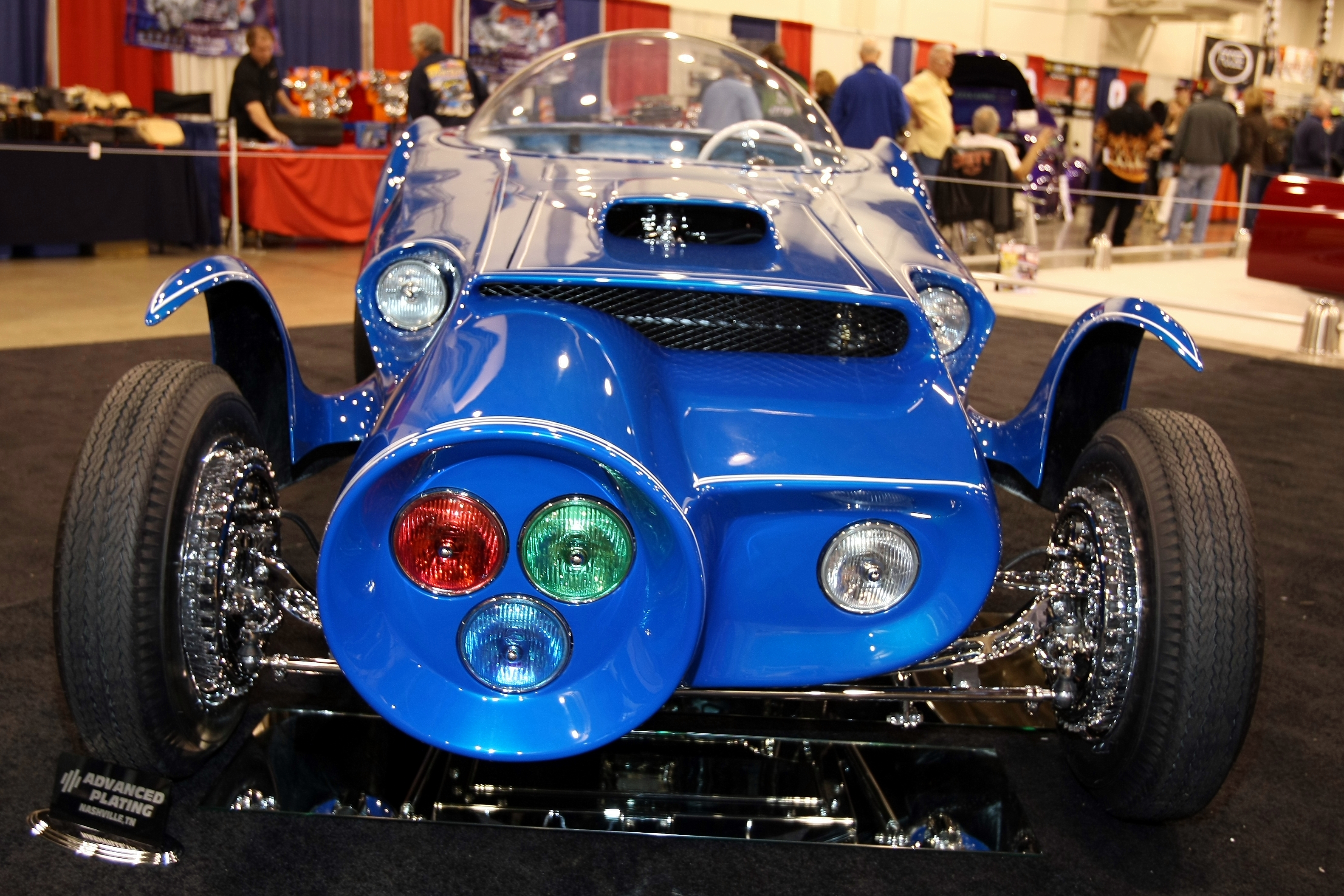 Jerry Thompson, CC BY 2.0, Wikimedia Commons
Jerry Thompson, CC BY 2.0, Wikimedia Commons
Orbitron (1964)
Quite infamously, the Orbitron mysteriously disappeared during the 1970s and remained elusive for decades. However, it eventually reared its head in Ciudad Juárez, Mexico of all places—used as part of an advertisement. Though its bare bones were still in working order, the car itself needed to be restored to its former glory.
You May Also Like:
Inside Cristiano Ronaldo's Car Collection: Here Are His Coolest Cars


